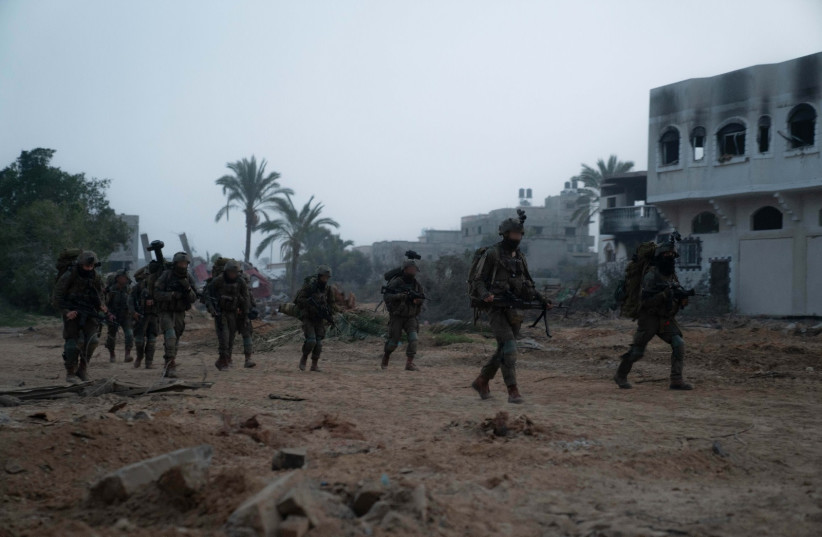IDF sources have indicated that the military may be close to control of Khan Yunis.
There is still no exact timeline, but IDF sources have registered a drop in the degree of resistance of Hamas forces which had remained strong for most of the two months of fighting in southern Gaza.
The large push in western Khan Yunis which began around a week ago and led to the killing of hundreds of Hamas terrorists seems to have caused a leap forward in progress for the IDF.
In the north of the Gaza Strip, soldiers from the 5th Brigade located and destroyed a tunnel route used by the terrorists in the area.
Egoz fighters of the Commando Brigade identified a terrorist squad wielding RPGs and eliminated it.

In parallel, fighters of the Maglan special forces unit killed several terrorists and found weapons in the Khan Yunis area, according to the IDF.
Combatants of the Paratrooper Brigade also continued to strike terror targets in Khan Yunis, locating numerous weapons.
Subsequently, the air force, in cooperation with troops of the 7th Brigade, killed two terrorists in the surroundings of the city using a fighter jet, the IDF added.
IDF continues operations in the center of the Strip
In the center of the Strip, the Nahal Brigade directed an unmanned aircraft from a distance, killing a terrorist who was located near them.
Regarding the battle to eliminate Hamas tunnels, The Wall Street Journal reported that only 20-40% of all of Hamas’s tunnel network has been destroyed or neutralized.
On November 14, The Jerusalem Post reported – based on IDF sources – that while a large number of attacks on tunnel shafts were being cited by the IDF, only around 30% of Hamas’s tunnels in northern Gaza had been fully destroyed to date, requiring significantly more time and investment of resources.
IDF sources said at the time that, unlike the 2014 Gaza conflict when the IDF merely sought to neutralize portions of tunnels, this time the IDF sought to destroy all aspects of Hamas’s tunnel network.
After the IDF neutralized portions of Hamas’s tunnel network in 2014, the terror group responded by simply digging around the cave-ins to reconnect the largely intact disparate tunnels at other spots.
On December 3, the Post reported that while the IDF had taken control of 80% or more of northern Gaza by mid-November, it still may only have destroyed 20% or less of northern tunnels to date, without even having done much against southern Gaza tunnels.
Being that more than two weeks had passed, and the IDF estimates of how much of Hamas’s tunnel had been destroyed had dropped 10%, it became clear that the IDF’s pre-war estimates about the extent of the terror group’s tunnels had dramatically underestimated the problem.
On December 21, the Post reported that IDF sources had said that it would take “years” to destroy the entire tunnel network.
In that light, the Wall Street Journal report, if true, would indicate that some moderate progress has been made against the tunnel network in the last month, but that the estimate of a years-long project to fully eliminate them seems to be accurate.
In the North, the IDF said its aircraft and helicopters struck Hezbollah targets in Zevkin, Hula, Marwahin, Dhayra, and Ayta ash-Shab, including lookout posts and terror infrastructure.
In recent weeks, the IDF has started to attack a much larger number of Hezbollah forces in multiple villages simultaneously or in a single day.
Also, the IDF attacked a Hezbollah command center and other terror infrastructure in southern Lebanon.
Hezbollah fired a salvo of rockets at the Margaliot and Zar’it areas, with the IDF saying the rockets landed harmlessly in open areas.
Further, the IDF stated that it had launched interceptor missiles at two “suspicious aerial targets,” while being vague about whether the defensive missiles hit their targets.
All told there were 14 rocket sirens on Sunday, most in the North, but four in the South. It was the fourth consecutive day of rocket sirens in the South, but the numbers have remained in single digits with no damage reported.
The IDF announced that it had punished a group of reservists on Sunday for using IDF property to express political opinions, such as opposition to any slowing down of the war.
The IDF High Command is in favor of continuing the war, but does not allow the use of military property to promote political views on either side of the spectrum.
Another IDF announcement said that the military’s logistics command had provided three million winter items for troops to better endure the current colder conditions.